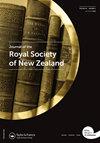来自新西兰的一条上新世箱鱼(四齿形,介形虫科)——对未来环境变化的预测?
IF 2.1
4区 综合性期刊
Q2 MULTIDISCIPLINARY SCIENCES
引用次数: 0
摘要
摘要本文报道了最近在新西兰北岛上新世发现的一具有关节的箱鱼化石(四齿形,介形虫科)。标本采集于南塔拉纳基Waihi海滩的Tangahoe组,这是一个中上新世(约3.0-3.4 Ma)浅海沉积。箱鱼化石的标准长度为10.7厘米,估计总长度约为13-14厘米(尾鳍未保存)。这条鱼被保存在右侧,侧躺着,有一个完整的身体覆盖着融合的羟基磷灰石板,坚硬地包裹着鱼,这是箱鲀的特征。板的形状为六边形至半六边形,最大的靠近背中线。以前在北半球的遗址中记录了从古新世到第四纪的箱鱼化石,但在南半球却没有。最近的报告指出,箱鱼和其他几种热带太平洋鱼类现在在新西兰北部出现——来自塔拉纳基的上新世箱鱼,以及新西兰古代史上一个有趣的补充,也可能反映出气候变化的持续影响将如何使新西兰回归到一个更温暖的海洋生态系统——类似于上新世时期盛行的生态系统。感谢Jean-Claude Stahl (NMNZ)的摄影,感谢John Buchanan-Brown提供的标本和他专业的准备技能,感谢本文早期草稿的审稿人提供的有帮助的意见。这项研究得到了the Papa Collection Development Fund的支持。披露声明作者未报告潜在的利益冲突。本文章由计算机程序翻译,如有差异,请以英文原文为准。
A Pliocene boxfish (Tetraodontiformes, Ostraciidae) from New Zealand – a preview of future environmental change?
ABSTRACTWe report on an articulated fossil boxfish (Tetraodontiformes, Ostraciidae) recently recovered from the Pliocene of the North Island of New Zealand. The specimen was collected from the Tangahoe Formation, a mid-Pliocene (c. 3.0-3.4 Ma) shallow marine deposit, at Waihi Beach, South Taranaki. The fossil boxfish measures 10.7 cm in standard length, with an estimated total length of c. 13–14 cm (the caudal fin is not preserved). The fish is preserved in right lateral view, lying on its side, and has an intact body covering of fused hydroxyapatite plates that rigidly encase the fish, as is characteristic of boxfishes. The plates are hexagonal to subhexagonal in shape and largest close to the dorsal midline. Fossil boxfish have previously been recorded from Northern Hemisphere sites ranging in age from Palaeocene to Quaternary, but not from the Southern Hemisphere. Recent reports note that boxfishes and several other tropical Pacific fish species are now being seen off of northern New Zealand – the Pliocene boxfish from Taranaki, as well as an intriguing addition to New Zealand’s paleohistory, may also reflect how the ongoing impact of climate change will return New Zealand to a warmer marine ecosystem – similar to what prevailed during the Pliocene.KEYWORDS: TetraodontiformesOstraciidaeBoxfishPlioceneNew Zealandenvironmental change AcknowledgementsOur thanks to Jean-Claude Stahl (NMNZ) for photography and to John Buchanan-Brown for making the specimen available and his expert preparation skills, and to the reviewers of an earlier draft of this paper for their helpful comments. This research was supported by the Te Papa Collection Development Fund.Disclosure statementNo potential conflict of interest was reported by the author(s).
求助全文
通过发布文献求助,成功后即可免费获取论文全文。
去求助
来源期刊

Journal of the Royal Society of New Zealand
综合性期刊-综合性期刊
CiteScore
4.60
自引率
0.00%
发文量
74
审稿时长
3 months
期刊介绍:
Aims: The Journal of the Royal Society of New Zealand reflects the role of Royal Society Te Aparangi in fostering research and debate across natural sciences, social sciences, and the humanities in New Zealand/Aotearoa and the surrounding Pacific. Research published in Journal of the Royal Society of New Zealand advances scientific knowledge, informs government policy, public awareness and broader society, and is read by researchers worldwide.
 求助内容:
求助内容: 应助结果提醒方式:
应助结果提醒方式:


